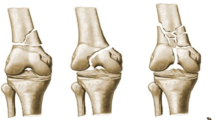Abstract
Distal femoral and proximal tibia epiphyseal fractures are rare, but they have a high incidence of complications. The Salter-Harris classification remains the most used classification system. Radiographic evaluation should be accompanied by meticulous neurovascular status monitoring.



Similar content being viewed by others
Bibliografia
Kasser JR, Beaty JH (eds) (2009) Rockwood and Wilkins’ fractures in children, 7th edn. Lippincott Williams & Wilkins, Philadelphia.
Poland J (1898) Traumatic separation of the epiphyses. Smith, Elder & Co, Londra
Salter RB, Harris WR (1963) Injuries involving the epiphyseal plate. J Bone Jt Surg Am 45:587–622
Peterson CA, Peterson HA (1972) Analysis of the incidence of injuries to the epiphyseal growth plate. J Trauma 12(4):275–281
Odgen JA (2000) Proximal tibial epiphyseal injuries. In: Odgen JA (ed) Skeletal injury in the child, 3rd edn. Springer, New York, pp 1005–1010
Aydin A, Topal M, Tuncer K, Şenocak E (2012) Salter-Harris Type III and Type IV combined fracture of the distal femoral epiphysis: a case report. Case Rep Orthop 2012. doi:10.1155/2012/317848. Hindawi Publishing Corporation
Tachdjian MO (2008) Pediatric orthopaedics, 4th edn. Saunders/Elsevier, Philadelphia
McCrory P (2003) Campbell’s operative orthopaedics, 10th edn. Mosby, St. Louis, pp 1512–1526
Riseborough EJ, Barrett IR, Shapiro F (1983) Growth disturbances following distal femoral physeal fracture-separations. J Bone Jt Surg Am 65:885–893
Gulabi D, Erdem M, Bulut G et al. (2013) Ipsilateral distal femoral and proximal tibial epiphyseal growth plate injury: a case report. J Med Case Rep 7:146
Arkader A, Warner WC, Horn BD et al. (2007) Predicting the outcome of physeal fractures of the distal femur. J Pediatr Orthop 27:703–708
Aitken AP (1965) Fractures of the proximal tibial epiphysial cartilage. Clin Orthop Relat Res 41:92–97
Stephens DC, Louis E, Louis DS (1974) Traumatic separation of the distal femoral epiphyseal cartilage plate. J Bone Jt Surg Am 56:1383
Lombardo SJ, Harvey JP Jr (1977) Fractures of the distal femoral epiphyses. Factors influencing prognosis: a review of thirty-four cases. J Bone Jt Surg Am 59:742–751
Bertin KC, Goble EM (1983) Ligament injuries associated with physeal fractures about the knee. Clin Orthop Relat Res 177:188
Basener CJ, Mehlman CT, DiPasquale TG (2009) Growth disturbance after distal femoral growth plate fractures in children: a meta-analysis. J Orthop Trauma 23:663–667
Vrettakos AN, Evaggelidis DC, Kyrkos MJ et al. (2012) Lower limb deformity following proximal tibia physeal injury: long-term follow-up. J Orthop Traumatol 13:7–11
Beslikas T, Christodoulou A, Chytas A et al (2012) Genu recurvatum deformity in a child due to Salter-Harris Type V fracture of the proximal tibial physis treated with high tibial dome osteotomy. Case Rep Orthop 2012. doi:10.1155/2012/219231. Hindawi Publishing Corporation
Blanks RH, Lester DK, Shaw BA (1994) Flexion-type Salter II fracture of the proximal tibia. Proposed mechanism of injury and two case studies. Clin Orthop Relat Res 301:256–259
Donahue JP, Brennan JF, Barron OA (2003) Combined physeal/apophyseal fracture of the proximal tibia with anterior angulation from an indirect force: report of 2 cases. Am J Orthop 32(12):604–607
Potenza V, Caterini R, Maglione P et al. (2011) Simultaneous bilateral flexion—Type Salter-Harris II fractures of the proximal tibia: a case report and review of the literature. Open Orthop J 5:315–318
Mubarak SJ (2009) Classification of proximal tibial fractures in children. J Child Orthop 3:191–197
Clement ND, Goswami A (2009) Salter-Harris II injury of the proximal tibial epiphysis with both vascular compromise and compartment syndrome: a case report. J Orthop Surg Res 4:23
Gautier E, Ziran BH, Egger B et al. (1998) Growth disturbances after injuries of the proximal tibial epiphysis. Arch Orthop Trauma Surg 118(1–2):37–41
Burkhart SS, Peterson HA (1979) Fractures of the proximal tibial epiphysis. J Bone Jt Surg Am 61:996
Shelton WR, Canale ST (1979) Fractures of the tibia through the proximal tibial epiphyseal cartilage. J Bone Jt Surg Am 61:167
Poulsen TD, Skak SV, Jensen TT (1989) Epiphyseal fractures of the proximal tibia. Injury 20:111
Wozasek GE, Moser KD, Haller H et al. (1991) Trauma involving the proximal tibial epiphysis. Arch Orthop Trauma Surg 110:301
Atkin DM, Fithian DC, Marangi KS et al. (2000) Characteristics of patients with primary acute lateral patellar dislocation and their recovery within the first 6 months of injury. Am J Sports Med 28:472
Pournaras DI (2006) Operative orthopaedics, 1st edn. Kodikas, Thessaloniki, pp 393–394
Author information
Authors and Affiliations
Corresponding author
Ethics declarations
Conflitto di interesse
Gli autori Vito Pavone, Flavia Alberghina e Giuseppe Sessa dichiarano di non aver alcun conflitto di interesse.
Consenso informato e conformità agli standard etici
Tutte le procedure descritte nello studio e che hanno coinvolto esseri umani sono state attuate in conformità alle norme etiche stabilite dalla dichiarazione di Helsinki del 1975 e successive modifiche. Il consenso informato è stato ottenuto da tutti i pazienti inclusi nello studio.
Human and animal rights
Per questo tipo di studio non è richiesto l’inserimento di alcuna dichiarazione relativa agli studi effettuati su esseri umani e animali.
Rights and permissions
About this article
Cite this article
Pavone, V., Alberghina, F. & Sessa, G. I distacchi epifisari del ginocchio. LO SCALPELLO 29, 147–152 (2015). https://doi.org/10.1007/s11639-015-0118-8
Published:
Issue Date:
DOI: https://doi.org/10.1007/s11639-015-0118-8




